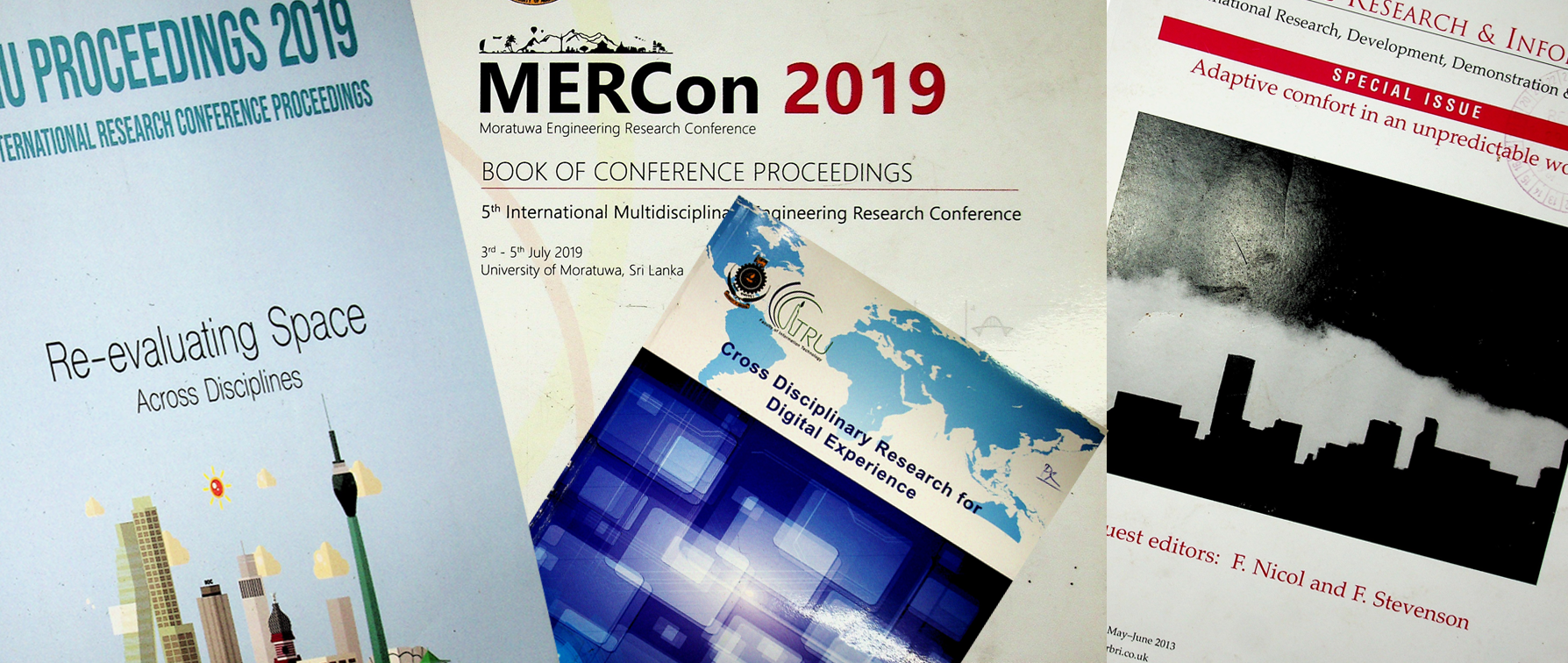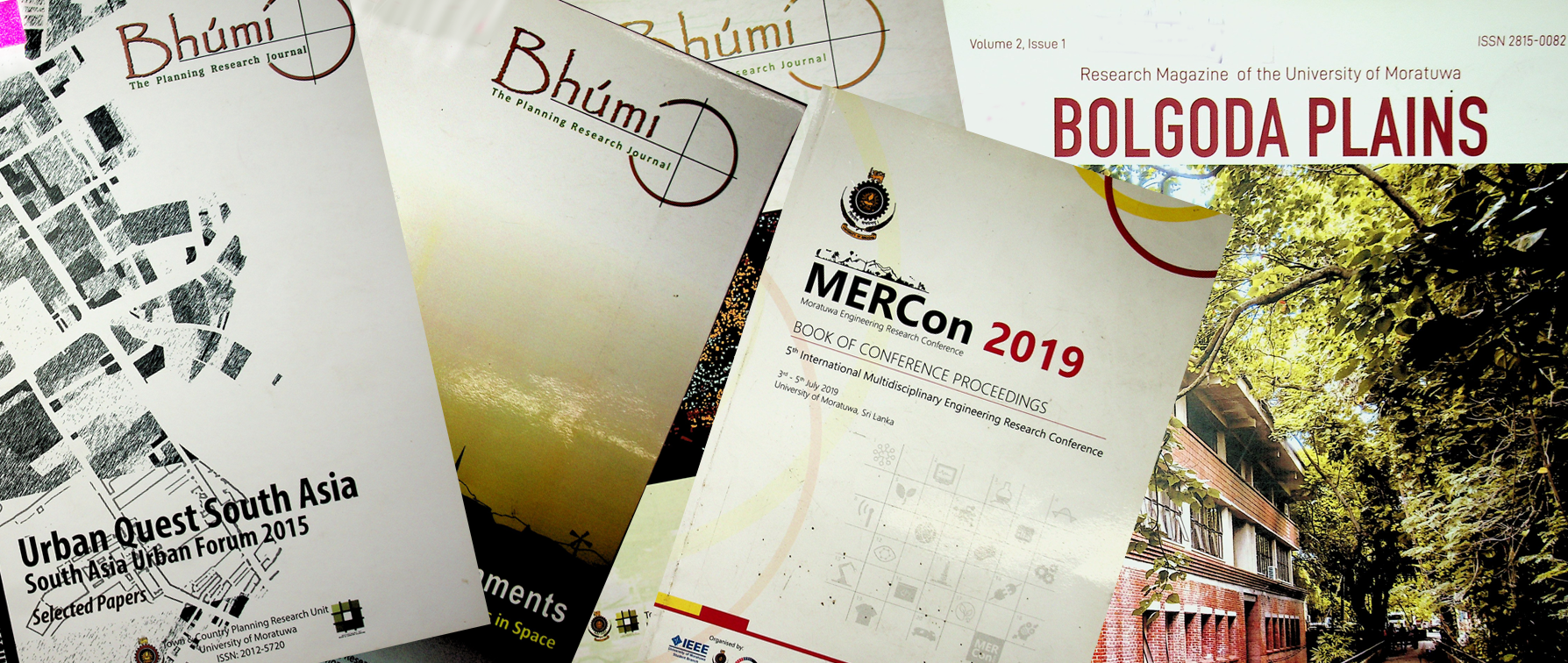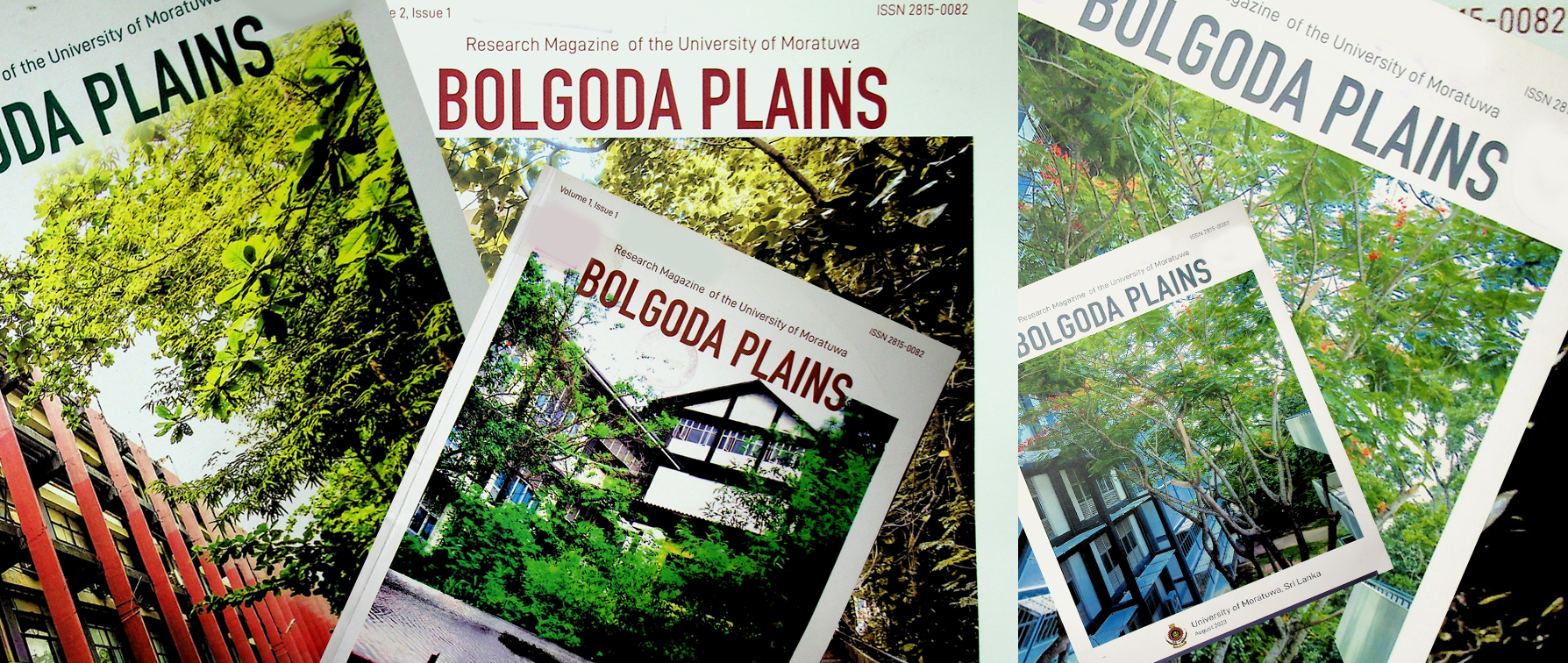Institutional-Repository, University of Moratuwa
Welcome to the University of Moratuwa Digital Repository, which houses postgraduate theses and dissertations, research articles presented at conferences by faculties and departments, university-published journal articles and research publications authored by academic staff. This online repository stores, preserves and distributes the University's scholarly work. This service allows University members to share their research with a larger audience.
 Research Publications |  Thesis & Dissertation |  E- Books |



 UoM Journal Publications |  UoM Conference Proceedings |  Articles published in Scimago's Q1 journals |  UoM Research Reports |  Other Articles authored by UoM staff |
Recent Submissions
item: Article-Full-text
Society, culture, architecture: impressions in Ahmedabad
(Integrated Design Research, University of Moratuwa) Nair , N
The historical landscape of India is woven from texts by scholars, rulers' biographies, travelogues, and folklores. A deeper search into the cultural identity of a place is facilitated by studying architecture, material and construction, motifs and ornamentations. The city of Ahmedabad, an important royal capital of western India of the Gujarat Sultanate in the fi fteenth and sixteenth centuries, is a suitable case study. This research investigates how the structures in Ahmedabad refl ect the stories of their patrons, socio-political context, mythology, religion, textiles, and craftsmanship. The study uses the Ahmed Shah Mosque (1414 AD) and Rani Sipri Mosque (1514 AD) as its cases. With a focus on motifs and ornamentations, the paper unveils the stories of how the city of Ahmedabad developed economically and politically, how the patrons changed from kings to queens, how the method of construction evolved from a method of assemblage to a detailed design process and how the Indo-Islamic architecture of Gujarat has its provincial influences deeply ingrained in each motif while respecting the sensibilities of the religions. The research adopts a multidisciplinary approach, combining archival research and photographic documentation to discuss the relationship between design, architecture and cultural identity.
item: Article-Full-text
An Investigation into the challenges faced by batik craftsmen in Sri Lanka
(Integrated Design Research, University of Moratuwa) Reshani , P; Senanayake , R
This research explores the practice of batik craftsmanship in Sri Lanka, focusing on its unique artistic elements and the challenges faced by craftsmen. Despite its rich cultural heritage, the Sri Lankan batik industry has seen limited growth, largely due to insufficient documentation and understanding of the challenges encountered by artisans. This study addresses this gap by examining the experiences of five batik craftsmen from diverse regions—Puttalam, Kurunegala, Kandy, Colombo, and Galle—selected for their representation of the craft's geographic spread. Using a case study approach and qualitative methods, data were gathered through semi-structured questionnaires and analyzed thematically. Four key themes emerged: Cultural Impact, Socio-economic Challenges, Environmental Challenges, and Production Challenges. The findings revealed that batik craft in Sri Lanka is entirely handmade, characterized by distinctive motifs, color palettes, inspirations, and the exceptional artistic skills of its craftsmen. However, the industry faces signifi cant hurdles in socio-economic conditions, environmental sustainability, and production processes. To support the sustainability and growth of Sri Lankan batik, the study recommends documenting unique practices, promoting awareness programmes, fostering knowledge sharing on sustainable methods, and encouraging government support for the craft. These measures aim to preserve and enhance the legacy of batik craftsmanship in Sri Lanka.
item: Article-Full-text
Indo-Futurism in its infancy: a critical examination of the movement’s emerging maturity
(Integrated Design Research, University of Moratuwa) Mudgal , S; Sinha , P
When considering disciplines such as speculative design, futures research, and design fiction, it is necessary to recognize the ongoing influence of past and present in shaping future imaginaries. In recent years, futurism has gained traction as a tool to imagine and re-imagine collective pasts, presents, and futures in response to environmental, social, and political challenges, contributing to the rise of Indigenous Futurisms worldwide. A prominent example is Afrofuturism, now a well-established movement across art, literature, fi lm, and design, which constructs alternate, non-West-centric futures rooted in ancient values, cultural identity, and responses to local environmental concerns while incorporating elements of Black history and culture. In the Indian subcontinent, a similar visual and literary language has emerged as a response to the legacies of decolonisation and contemporary challenges, allowing creators to celebrate their cultures with agency. Indofuturism, like Afrofuturism, synthesises ancient wisdom with contemporary innovation, drawing from spiritual heritage, artistic expression, and technological symbolism; it at times envisions futures where traditional values coexist with cutting-edge technologies, and at others reflects preferred pasts projected into alternative futures. Although still in its infancy, this study seeks to understand Indofuturism’s cultural foundations and examine the factors that may enable it to mature into a recognisable design language, supporting designers and researchers in forecasting its potential trajectory within society.
item: Article-Full-text
Material utilization practices in Weweldeniya craft community, Sri Lanka
(Integrated Design Research, University of Moratuwa) Deshanika , SNT; Nugawela , CT
The craft industry in Sri Lanka has been an integral part of the economy for centuries, contributing to both rural livelihoods and national trade. The Weweldeniya craft community in Sri Lanka has a rich heritage of producing intricate and culturally signifi cant craft items using traditional techniques. However, the industry faces pressing challenges primarily due to sourcing materials from various geographic locations, incurring substantial transportation costs. To address these multifaceted challenges, the craftsmen have adopted a resource optimization strategy aimed at minimizing waste and maximizing resource utilization. This study investigates the materials commonly used in Weweldeniya crafts, their integration into production, and the techniques employed to transform raw materials into fi nished products. It examines the sustainable practices adopted by craftsmen to optimize resources, with a focus on the 3R principles (Reduce, Reuse, Recycle) and lean manufacturing pull systems. Findings highlight that despite economic pressures, craftsmen effectively manage resources, particularly various rattan varieties, to meet market demands. This research employs a mixed-methods approach while dominating qualitative approach to provide a comprehensive understanding of the intricate material utilization practices and sustainability. The study concludes that Weweldeniya craftsmen, despite facing rising transportation costs and fuel prices, have demonstrated adaptability through resource optimization. However, waste analysis reveals that offcuts and trimmings account for 40% and 27% of production waste, respectively, highlighting the need for better waste management and recycling practices. Enhancing technological integration and recycling could drive further innovation and skill development. Addressing these areas will be vital for sustaining the rattan industry in Weweldeniya.
item: Article-Full-text
Graphics of spice packaging on Sri Lankan supermarket shelves
(Integrated Design Research, University of Moratuwa) Sewwandi , AI; Samarawickrama , S
This study investigates how graphic design elements in spice packaging—specifically color, typography, and imagery—enhance product visibility and differentiation in Sri Lankan supermarkets. With over 20 competing brands and 40 spice varieties sharing limited shelf space, the study addresses a gap in packaging design literature by examining local visual strategies in a densely saturated retail context. This study employed a two-phase qualitative approach: a deductive phase that applied design criteria from existing literature to guide analysis, and an inductive phase involving field observations in Moratuwa supermarkets to identify context-specific packaging patterns. Using a coded visual analysis of 30 packaging samples, the study identifies how high-saturation colors, legible typography, and product-focused imagery improve visibility across consumer shelf zones (recognition, buy, curiosity). Findings reveal that high-saturation colors, clear multilingual typography, and selective imagery enhance product visibility across supermarket shelf zones. Local spice packaging predominantly uses analogous color schemes—reds, yellows, and browns—with some incorporating green accents for contrast. Most employ white or black text on red or yellow backgrounds to ensure legibility. Imagery is inconsistently applied: 54% include product photographs, while 40% use none. Transparent PET packaging further supports brand differentiation by showcasing authenticity. The study underscores graphic design’s strategic role in FMCG environments and calls for further research into how localized design influences consumer perception in South Asian markets.
